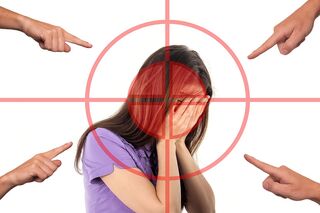Embarrassment
Undeserved Shame: Why Does It Occur?
The functions and malfunctions of shame (second article in a series).
Posted July 8, 2020 Reviewed by Kaja Perina

Some years ago, Joseph Dick, a Navy seaman, was accused and convicted of a rape and murder he did not commit. He spent 12 years in prison before he was finally proven to be innocent. During those years he suffered not only from the imprisonment but also from shame. Why? He knew he didn’t commit the crimes he was accused of, so why did he feel and exhibit shame?
This story, told by Theresa Robertson and her colleagues (2018) in the introduction to a research report, illustrates what much research shows about shame. Shame tracks not our knowledge of whether we actually did something wrong (guilt more often does that), but, instead, tracks what we think other people believe about us. As I described in the previous post, shame came about, by natural selection, as a means of trying to gain or regain social acceptance by those who think poorly of us. It doesn’t matter whether or not we actually committed a crime. If others believe we committed it, and if we have no means to convince them otherwise, then our best chance to be accepted by those people, upon whom we may depend, is to show remorse, and shame is an automatic, effective way of showing that remorse. If you think I did something awful, you will be more likely eventually to accept me back into your circle if you see the shame in my face, posture, and words than if you don’t. You will see me as less dangerous than if I failed to exhibit shame.
In some cases, people even manage, in their shame, to convince themselves that they actually did commit a crime that they did not commit. An advantage of that, I imagine, is that their belief that they committed the crime leads them to experience guilt as well as shame, which would lead to even more convincing nonverbal and verbal expressions of remorse. Our emotions, as products of natural selection, are not so much about justice as about self-preservation.
The theory that shame is activated in a person when others, correctly or incorrectly, possess or might possess negative information about the person is called the information threat theory of shame (Robertson et al, 2018; Sznycer et al, 2018). It is supported not just by anecdotes such as the story of Joseph Dick, but also by a good deal of systematic research.
In one experiment, Robertson and her co-workers (2018) asked participants to imagine that they worked as a waiter at a bar and that, because they needed smaller bills, they dropped a $50 bill into the shared tip jar and took out an equivalent amount in smaller bills. In some cases they were asked to imagine further that a co-worker walked into the room and may have seen them take the bills out of the jar but not seen them put the $50 bill into it, and in other cases they imagined that they were alone in the room the entire time. Subsequently they were asked to rate the intensity of shame they would feel if the imagined scene had really happened. As predicted by the information threat theory, the participants reported that they would feel far more shame in the scene where someone might have seen them than in the scene where they were alone. They were equally innocent in both cases, but what mattered was how others may have perceived them.
In another experiment, the same researchers asked participants to engage in a laboratory game that involved cooperation with other participants. Afterward, they presented each participant with false information about how the others viewed them. Some were told that the other participants had excluded them from the next round of the game because of their failure to cooperate, and others were told that the other participants had voted to include them because of their excellent cooperation. The result, as predicted by the information threat theory, was that those who were excluded felt shame, even if in fact they had cooperated to the full extent that was possible, and those who were included did not feel shame, even if they had not cooperated. Again, shame was determined not by the morality of one’s actual behavior, but by one's belief about others’ perceptions of their behavior.
The information threat theory also explains why people who are unfairly stigmatized by others around them—perhaps because of race, sexual orientation, or a physical handicap—might feel shame despite having done nothing wrong. This helps explain the value of the Black Pride and Gay Pride movements of the past. These were explicit, conscious strivings to overcome undue, socially imposed shame by supporting one another’s pride. Pride is the opposite of shame and the antidote to undeserved shame that is no longer serving an essential function.
And now, what do you think? What are your experiences with shame? Do they or do they not fit with the information threat theory? How have you or others you know dealt with undeserved shame? This blog is, among other things, a forum for discussion. Your thoughts and questions are treated with respect by me and other readers. Please put your comments here, by clicking on the little comment balloon below, rather than by sending them to me by private email. I get more email than I can handle, but I do try to read all blog comments and respond if I think I have something useful to add.
References
Robertson, T. E., Sznycer, D., Delton, A. W., Tooby, J., & Cosmides, L. (2018). The true trigger of shame: social devaluation is sufficient, wrongdoing is unnecessary. Evolution and Human Behavior, 39, 566-573.
Sznycer, D., Tooby J., Cosmides, L., Porat, R., Shalvi, S., & Halperin, E. (2016). Shame closely tracks the threat of devaluation by others, even across cultures. Proceedings of the National Academy of Sciences, 113, 2625-2630.


